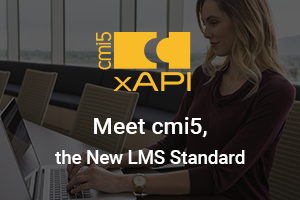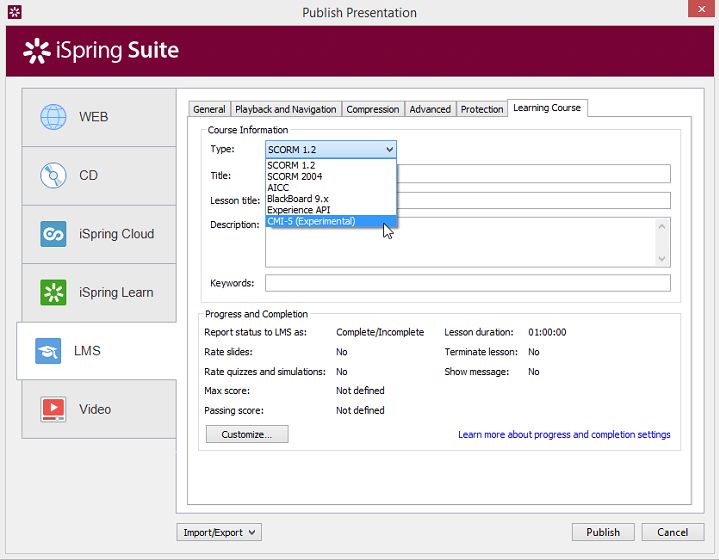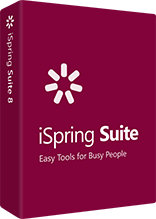iSpring Now Supports cmi5, the Next Generation of SCORM

Starting this June, iSpring authoring tools support publishing to the new format for LMSs – cmi5.
Before, those in e-Learning had to decide whether to favor SCORM or xAPI. cmi5 is a bridge between SCORM and xAPI that consolidates the best of these two standards for LMSs. To learn what cmi5 is and why you should use it, read this article.
What is cmi5?
cmi5 is a brand-new standard for LMSs developed by ADL (Advanced Distributed Learning Initiative). In short, cmi5 is a set of rules providing all the capabilities of SCORM and xAPI at the same time.
The official release
ADL officially announced the much-anticipated Quartz release on June 1st, 2016. It is the first release of the cmi5 specification that is ready for production implementation.
iSpring and cmi5
iSpring is one of the first vendors to support the brand-new LMS format. We’re happy to provide users with innovative new capabilities. The new publishing option was included in the upgraded versions of iSpring Suite on June 2nd, 2016.
iSpring fully supports the latest version of the cmi5 specification, dubbed Quartz. For now, the support has an Experimental status, as there are not many LMSs officially compatible with cmi5 yet.

Why use cmi5 instead of SCORM
These few reasons may encourage you to use the new standard instead of SCORM.
1. It allows offline mobile learning
Unlike with SCORM, cmi5 courses can be taken both online and offline. Students can take course materials when there’s no Internet connection with special mobile apps. The progress will be saved and sent to the LMS once the connection is restored.
2. It records any kind of activity
With SCORM, you can only store predefined parameters. Unlike SCORM, the data that cmi5 tracks is not limited: you can get detailed information on learners’ activity, such as:
- Store an audio recording of your student responding to a question
- Store a video of your student performing a task
- Store an essay written by your student
It’s also possible to track images, PDFs, audio and video files, and simulations.
3. It enables studying outside an LMS
SCORM tracks formal instructor-led learning and leaves out much of modern learning that happens outside an LMS. Consider gaming and simulations, social learning and mobile apps – all these sources can be used and tracked with the cmi5 standard.
4. It’s easier to implement
While SCORM is complicated, the cmi5 specification is only a few pages. It works “on top of” xAPI, so if you know the latter, you should be able to implement cmi5 quite easily.
5. It allows content distribution
If you have worldwide students and you really care about them, then save them from using SCORM. With this standard, content must be stored on the same server as your LMS. This means that learners from far away must be really patient with the content load times. The question is becoming even more important, as content modules are getting bigger and bigger.
With cmi5, only the course structure is imported, not the actual content. This means that content itself can reside anywhere. You can choose to store materials on a content distribution network (CDN) with several servers around your country or even around the world, so when your students open the content, they will automatically connect to the closest server.
6. It provides a better user experience
This is what Art Werkenthin, president of RISC, Inc. and a member of the ADL cmi5 committee, says about the SCORM problem with pop-up windows:
If you have ever used SCORM, you know about the pop-up windows. With SCORM, you get at least two windows: one for the LMS and the other for the SCORM content. Usually, you get more than two because sometimes the SCORM content decides to have its own “player” window.
If you are an LMS administrator, you know you have to watch out for SCORM’s arch enemy—the pop-up blocker! How many times have you answered a call from a student who says, “The content won’t open”? You dread going on the hunt for all the possible pop-up blockers that may be installed on the student’s workstation. (Tip from the trenches: I’ve found as many as seven pop-up blockers on a single machine.)
Even if you clear out all the pop-up blockers, you still get the occasional student that hates pop-up windows … so they just close them immediately, thereby breaking your SCORM module.
Finally, if you want to support mobile, pop-ups are a “no-no.”
Luckily, this was one of the first issues addressed in cmi5. Content can now launch in the same window as the LMS. The LMS disappears and the content opens; simple as that. When the content is done, it disappears and the LMS returns—right where you left off.
How cmi5 enhances xAPI
Here is how Ben Clark of Rustici Software describes the value cmi5 adds to xAPI: “xAPI is wide open, there’s so much this standard can do that people don’t know what to expect out of it and they don’t know how to track certain things consistently. cmi5 is there to put some of the rules back on top of xAPI. And even though the new standard does have more rules and provides more structure, instructional designers still have a wide open field to track whatever they want to.”
Conclusion
Today, there’s no need to choose between the interoperability of SCORM and the flexibility of xAPI anymore. The next generation of e-Learning standards, cmi5, has it all. This unified version does what SCORM was originally intended to do while tracking unlimited data, supporting mobile learning, and much more.
iSpring is happy to support the evolution of learning ecosystems. You can take advantage of the new capabilities with iSpring authoring tools. To do that, publish your content to cmi5 and upload it to a cmi5-compliant LMS. You can learn more about the new standard on the official specification page.

